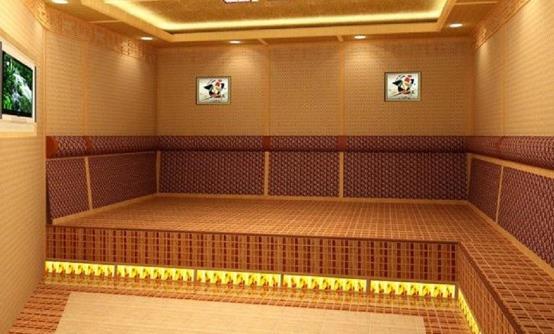- 本文目录导读:
- Sauna: Ancient Heat Therapy
- Traditional Chinese Medicine (TCM): A Holistic Approach
- Integration of Sauna with TCM Principles
- Health Benefits and Considerations
- Practical Considerations and Precautions
- Conclusion
In recent years, the integration of traditional practices like sauna with the principles of Traditional Chinese Medicine (TCM) has gained significant attention in the realm of wellness. Sauna, a therapeutic practice originating from Nordic cultures, and TCM, an ancient system of health and healing from China, might seem worlds apart in origin and approach, but their underlying philosophies share common ground when it comes to promoting holistic health.
Sauna: Ancient Heat Therapy
Sauna, derived from the Finnish word meaning "bathhouse," involves exposure to dry heat in a controlled environment, typically reaching temperatures between 70 to 100 degrees Celsius (158 to 212 degrees Fahrenheit). This heat induces profuse sweating, which is believed to offer a range of health benefits. Advocates of sauna therapy highlight its ability to promote detoxification through sweating, enhance cardiovascular function by improving circulation, and even potentially aid in pain relief and relaxation.
In the context of modern wellness, sauna has evolved beyond its traditional roots into various forms such as infrared sauna, which uses infrared heaters to emit radiant heat that is absorbed directly by the body. This type of sauna is praised for its ability to penetrate deeper into tissues compared to traditional saunas, potentially offering more profound therapeutic effects.
Traditional Chinese Medicine (TCM): A Holistic Approach
TCM, on the other hand, encompasses a broad range of practices that have been refined over thousands of years. At its core, TCM emphasizes balance and harmony within the body, viewing health as a state of dynamic equilibrium between opposing forces such as yin and yang. Central to TCM's approach are modalities like acupuncture, herbal medicine, dietary therapy, and therapeutic exercises such as qigong.

Key principles of TCM relevant to wellness include the circulation of Qi (vital energy) and the concept of meridians, pathways through which Qi flows throughout the body. According to TCM theory, disruptions or imbalances in Qi flow can lead to illness, pain, or emotional distress. The goal of TCM treatments is to restore harmony and optimize the body's natural healing abilities.
Integration of Sauna with TCM Principles
The integration of sauna practices with TCM principles represents a convergence of ancient healing traditions from different cultural origins. Proponents suggest that sauna therapy aligns with several TCM concepts, particularly in its potential to promote detoxification and enhance circulation. From a TCM perspective, sweating induced by sauna can be seen as a means to expel pathogenic factors and toxins, thereby supporting the body's detoxification processes.
Furthermore, the heat generated in sauna sessions is believed to open the body's pores and facilitate the movement of Qi and blood, which are fundamental concepts in TCM. Improved circulation, in TCM terms, means better nourishment of tissues and organs, supporting overall vitality and resilience against illness.
Health Benefits and Considerations
The combined benefits of sauna and TCM principles are increasingly supported by scientific research. Studies have shown that sauna therapy can indeed promote cardiovascular health by improving blood flow and reducing blood pressure. Moreover, regular sauna use has been associated with reduced risk factors for cardiovascular diseases such as coronary artery disease.
In the realm of TCM, the application of heat has long been recognized for its therapeutic effects. TCM practitioners may recommend heat therapies like moxibustion (burning of mugwort herb) to stimulate acupuncture points and enhance Qi flow. Sauna therapy, with its similar emphasis on heat application, can be viewed as a complementary approach to promoting Qi circulation and overall vitality according to TCM principles.

Practical Considerations and Precautions
While sauna therapy and TCM principles offer promising health benefits, it is essential to approach their integration mindfully. Individual responses to sauna heat can vary significantly, and factors such as age, health status, and tolerance to heat should be considered. In TCM practice, personalized assessment of an individual's constitution and health condition guides the application of therapeutic interventions, including sauna therapy.
It is advisable for individuals new to sauna therapy, especially those with pre-existing health conditions, to consult healthcare providers familiar with both sauna therapy and TCM principles. Integrative approaches that combine sauna therapy with TCM modalities should be tailored to individual needs and conducted under appropriate supervision to optimize safety and efficacy.
Conclusion
In conclusion, the integration of sauna practices with Traditional Chinese Medicine represents a harmonious fusion of ancient healing traditions aimed at promoting holistic wellness. By harnessing the therapeutic benefits of heat and aligning with TCM principles of balance and vitality, sauna therapy offers a promising avenue for enhancing physical health, supporting detoxification, and optimizing overall well-being.
转载请注明:成都会所桑拿-四川成都休闲桑拿推荐论坛! » 武汉休闲 » The Synergy of Sauna and Traditional Chinese Medicine in Wellness
版权声明
本文仅代表作者观点,不代表成都休闲网立场。
本文系作者授权发表,未经许可,不得转载。




























